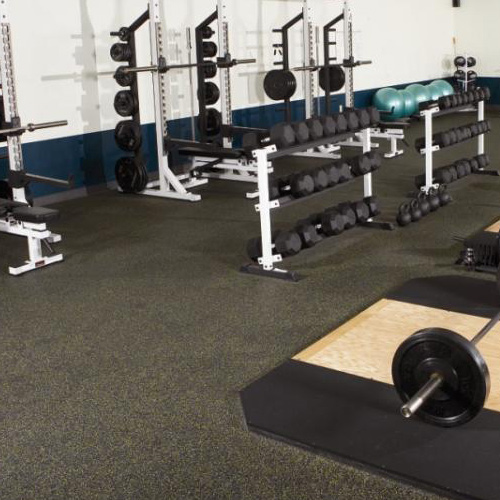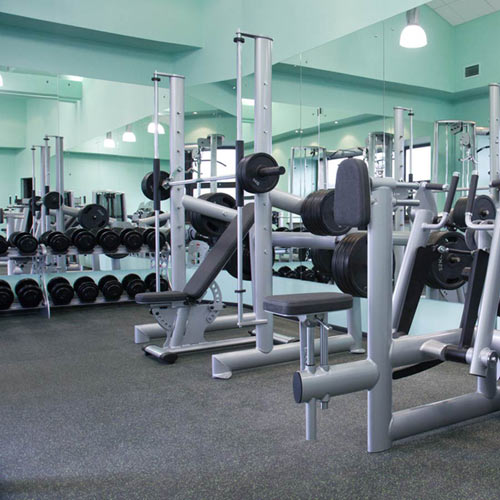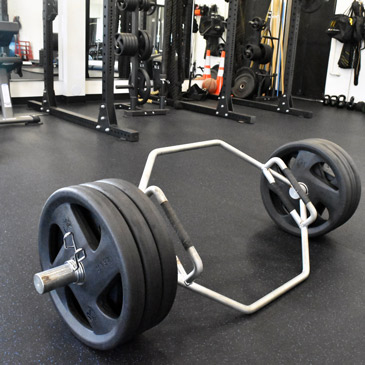Rubber Weight Room Flooring - Home and Commercial
Related Product: Rolled Rubber Pacific 8 mm Regrind Per SF
One of the first things to consider when choosing flooring for a weight room is how much traffic/abuse it will need to take. If your weight training facility will be used for competitive athletic teams, such as a college or pro football team, it will need to be thicker and much more durable that those used in most home gyms or senior centers.
Rubber has built a reputation for protecting the subfloor, reducing vibration and cutting noise from machines and free weights. It can handle heavy equipment and foot traffic. Rubber floors are extremely durable, easy to clean, often made from recycled tires and is recyclable again at the end of its life.
Rolled Rubber

The thickness of your rubber flooring is where you are going to find the biggest differences in durability, generally speaking. A 1/4 to 3/8 inch rubber floor will suffice for light to moderate use while heavily-used areas will require a thicker rubber surface match that lifespan. In areas where weights will be dropped, 1/2 rolled rubber flooring may be required to handle the impact without damaging the subfloor. Although many thicker rubber floors can greatly outlast a 15-year warranty, kettlebells, hex head dumbbells and heavily-loaded barbells are especially punishing to any flooring surface when dropped and will take its toll on even the best rubber floors eventually.
Rolled rubber is the cheapest rubber weight room flooring option for large areas and it leaves the fewest seams. However, due to the nature of its size and weight (often coming in 25-50 foot long rolls), installation can be cumbersome without help, and thickness is limited - generally to 1/2 inch.
Rubber Floor Mats

Rubber floor mats, often sold in 4x6 foot sizes, offer another economical option with the capability of a slightly thicker surface. Rubber floor mats often range from 3/8 to 3/4 inch thicknesses. While heavy and generally stable, these straight-edge mats can separate from each other over time, especially when covering a large surface area. They are often used as supplemental padding in areas where weights will be dropped.
Interlocking Puzzle Mats

Interlocking, puzzle-style tiles offer convenient installation and a tight, durable fit without shifting. They are often for smaller rooms due to the much higher cost per square foot. The smaller 2 to 4 foot tiles (1/4 to 3/4 inch thick) are easier to manage, especially if installed by a single person.
For cardio areas, where shock absorption is less of an issue, thinner rubber flooring will suffice just fine. Some gym-goers prefer the feel and warmth of carpeting in cardio areas, but be careful as cleaning can become an issue as stains and bacteria are hard to remove from most carpeted surfaces.
Athletic Rubber Gym Floor Tiles

For weight rooms with more specialized needs, athletic rubber floor tiles are a great solution. These tiles, while still interlocking utilize different forms of interlocks that are hidden under a straight edge for a classy finished look. These tiles are also thicker and features specialized support structures that are designed to reduce noise and vibration at a much better level than flat bottomed rolls, mats or tiles. They also offer a greater level of fatigue relief.
If your weight room shares a wall with a neighboring business or classroom, these tiles are a great way to keep the noise transfer at a minimum so you can train as hard as you'd like without worrying about disturbing your neighbors.
Alternatives to Rubber for Home Weight Room Floors
Foam and plastic materials can also be used for weight room flooring. Like carpeting, however, great care should be taken when or if you decide to use these materials. Foam will indent under heavy objects, so proper weight dispersement is a necessity. Plastic flooring such as StayLock tiles are rugged enough to handle heavy weight equipment and offers cushioning similar to foam, but typically carries shorter-term warranties than rubber weight room flooring.Whether you are a gym rat, fitness buff or someone just looking drop a few pounds, there is weight room flooring out there to fit your needs. Most likely, it will be some form of rubber.










